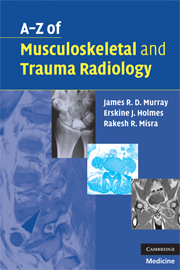Book contents
- Frontmatter
- Contents
- Acknowledgements
- Preface
- List of abbreviations
- Section I Musculoskeletal radiology
- Achilles tendonopathy/rupture
- Aneurysmal bone cysts
- Ankylosing spondylitis
- Avascular necrosis – osteonecrosis
- Femoral-head osteonecrosis
- Kienböck's disease
- Back pain – including spondylolisthesis/spondylolysis
- Bone cysts
- Bone infarcts (medullary)
- Charcot joint (neuropathic joint)
- Complex regional-pain syndrome
- Crystal deposition disorders
- Developmental dysplasia of the hip (DDH)
- Discitis and vertebral osteomyelitis
- Disc prolapse – PID – ‘slipped discs’ and sciatica
- Diffuse idiopathic skeletal hyperostosis (DISH)
- Dysplasia – developmental disorders
- Enthesopathy
- Gout
- Haemophilia
- Hyperparathyroidism
- Hypertrophic pulmonary osteoarthropathy
- Irritable hip/transient synovitis
- Juvenile idiopathic arthritis
- Langerhans-cell histiocytosis
- Lymphoma of bone
- Metastases to bone
- Multiple myeloma
- Myositis ossificans
- Non-accidental injury
- Osteoarthrosis – osteoarthritis
- Osteochondroses
- Osteomyelitis (acute)
- Osteoporosis
- Paget's disease
- Perthes disease
- Pigmented villonodular synovitis (PVNS)
- Psoriatic arthropathy
- Renal osteodystrophy (including osteomalacia)
- Rheumatoid arthritis
- Rickets
- Rotator-cuff disease
- Scoliosis
- Scheuermann's disease
- Septic arthritis – native and prosthetic joints
- Sickle-cell anaemia
- Slipped upper femoral epiphysis (SUFE)
- Tendinopathy – tendonitis
- Tuberculosis
- Tumours of bone (benign and malignant)
- Section II Trauma radiology
Myositis ossificans
from Section I - Musculoskeletal radiology
Published online by Cambridge University Press: 22 August 2009
- Frontmatter
- Contents
- Acknowledgements
- Preface
- List of abbreviations
- Section I Musculoskeletal radiology
- Achilles tendonopathy/rupture
- Aneurysmal bone cysts
- Ankylosing spondylitis
- Avascular necrosis – osteonecrosis
- Femoral-head osteonecrosis
- Kienböck's disease
- Back pain – including spondylolisthesis/spondylolysis
- Bone cysts
- Bone infarcts (medullary)
- Charcot joint (neuropathic joint)
- Complex regional-pain syndrome
- Crystal deposition disorders
- Developmental dysplasia of the hip (DDH)
- Discitis and vertebral osteomyelitis
- Disc prolapse – PID – ‘slipped discs’ and sciatica
- Diffuse idiopathic skeletal hyperostosis (DISH)
- Dysplasia – developmental disorders
- Enthesopathy
- Gout
- Haemophilia
- Hyperparathyroidism
- Hypertrophic pulmonary osteoarthropathy
- Irritable hip/transient synovitis
- Juvenile idiopathic arthritis
- Langerhans-cell histiocytosis
- Lymphoma of bone
- Metastases to bone
- Multiple myeloma
- Myositis ossificans
- Non-accidental injury
- Osteoarthrosis – osteoarthritis
- Osteochondroses
- Osteomyelitis (acute)
- Osteoporosis
- Paget's disease
- Perthes disease
- Pigmented villonodular synovitis (PVNS)
- Psoriatic arthropathy
- Renal osteodystrophy (including osteomalacia)
- Rheumatoid arthritis
- Rickets
- Rotator-cuff disease
- Scoliosis
- Scheuermann's disease
- Septic arthritis – native and prosthetic joints
- Sickle-cell anaemia
- Slipped upper femoral epiphysis (SUFE)
- Tendinopathy – tendonitis
- Tuberculosis
- Tumours of bone (benign and malignant)
- Section II Trauma radiology
Summary
Characteristics
Also known as heterotopic ossification.
Benign condition involving ossification of muscle and other soft tissues.
Majority of lesions described are secondary to trauma, including operative trauma such as total hip replacement.
Calcification occurs within the traumatised tissue.
Non-traumatic and hereditary forms are also described.
Common sites involved are the large muscles of the extremities (80%), chest and back.
Clinical features
Painful tender soft tissue mass – important to have a clear history of trauma, otherwise the suspicion of malignancy must be considered.
Decreased range of movement of the involved musculo-tendinous unit, which reduces the range of the joints supplied by that unit.
Pain decreases with time unlike most sinister pathology.
May be aymptomatic and diagnosed incidentally.
Can occur in periarticular situations, e.g. around the elbow following a paediatric supracondylar fracture.
Radiographic features
Faint soft-tissue calcification develops in 2–6 weeks, becoming smaller and organised by 5 to 6 months.
Separate from bone, but periosteal reaction may occur and can be mistaken for osteosarcoma.
May occur within the muscle for example ‘riders bone’ (adductor longus); ‘fencers bone’ (brachialis); ‘dancers bone’ (soleus).
May be periosteal at tendon insertion; Pellegrini–Stieda lesion (medial collateral ligament of knee).
CT – depends on age of lesion. Well-defined mineralisation at periphery of lesion after 4–6 weeks with diffuse ossification in mature lesion.
MRI – early lesions may reveal an ill-defined mass with heterogenous signal. Later, soft-tissue and bone-marrow oedema develop with decreased signal intensity surrounding the lesion due to mineralization/ossification.
Management
Directed towards diagnosis and exclusion of sinister pathology.
Symptomatic control with NSAIDs.
Indomethacin is usually first line for myositis and should be started early for best results.
Avoid painful aggressive rehabilitation/new trauma particularly after paediatric elbow trauma.
[…]
- Type
- Chapter
- Information
- A-Z of Musculoskeletal and Trauma Radiology , pp. 89 - 91Publisher: Cambridge University PressPrint publication year: 2008



